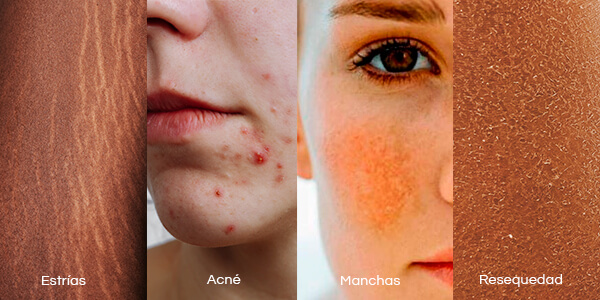In each stage of pregnancy, wonderful and at the same time chaotic changes take place, of a hormonal, immunological and emotional nature that end up affecting the skin of our pregnant patient.
Some of these changes are considered natural to this process and are called physiological. They generally do not require treatment and resolve over time. Others are considered pathological (consisting of disease). That is why its timely diagnosis and correct treatment make great differences.
Some skin conditions that can appear during pregnancy are:
Skin blemishes
There may be an accentuation of existing blemishes on the skin or the appearance of new blemishes due to hormonal action, especially estrogen. The most common is the result of a process called melasma. It may appear while pregnant or not. Its main treatment and prevention is sun protection.
Stretch marks
They are scars that arise when the collagen and elastin fibers that are in the dermis break, when the skin is stretched as the pregnancy progresses. Initially they look red and lumpy and over time they will look white, shiny, flattened and wide. They are very common in breasts, hips, abdomen, buttocks and legs. Its main treatment during pregnancy is hydration. At the end of this stage, more specific treatments can be provided.
Extreme dryness of the skin
Dryness and itching are very common, especially in extremities, and the main treatment is moisturizing, as well as good daily habits. Short baths, avoiding aggressions to the skin and applying remodeling active ingredients to the superficial layers of the skin is the key.
Capillary loss
It can be accentuated during pregnancy or 60-90 days after delivery. In general, treatments are not performed during pregnancy unless the fall is caused by vitamin deficiency.
Acne
Due to hormonal influence and the action of prenatal medications, acne may appear or worsen. Its main treatment is a basic skincare routine with mild active ingredients that regulate the amount of oil produced by the skin and balance the microorganisms that live in it. Facial cleansing protocols with dermatology are a very effective tool to help this treatment.

Other very common alterations are:
- Brittle nails
- Telangiectasia (red veins)
- Red Moles (Ruby Angiomas)
- Increase in the size of existing freckles and moles
- Seborrheic keratoses
Although each stage of pregnancy is specific and dynamic, the riskiest is the first trimester, since the placenta is highly permeable and the fetus is more sensitive to any damage.
Substances prohibited in pregnancy:
- Retinoids
- Salicylic acid
- Urea in concentrations greater than 3%
- Glycolic acid in concentrations greater than 15%
- Turmeric, ginger and deodorants with aluminum should also be avoided in general.
Safe substances:
- Lactic acid
- Azelaic acid
- Glycolic acid at low concentrations
- Mandelic acid
- Vitamin C
- Vitamin E
- Ferulic acid
- Bakuchiol
- Thiamidol, among others.
Home treatments
Moisturizers, superficial renovating acids of the skin, antioxidants, etc. The care routine should ideally be adapted from the preconception period, adjusted during pregnancy and modified as necessary in the postpartum period.
In-office treatments
Peelings, laser, radiofrequency associated with microneedling, robotic microneedling with or without medication release; among others. Ideally, wait until the lactation period or when it has finished, inclusive, depending on each case.
Take care and beautify your skin before, during and after pregnancy! Please do it with your dermatology specialist!
Laura Sofía Habib Araújo
Dermatologist
@LHDERMATOLOGY
Bogota, Colombia